
|
The weather had turned distinctly bleak over the past few days and we arrived to do the tramp on an overcast drizzly day. Turning off the highway, we were cheered by the sight of The Staging Post, part of the Hawkswood property and our first night's stop (as with many private walks, the tramp starts with overnight accommodation followed by the first stage of the walk the following morning). A group of quaint cottages were clustered near a large grove of trees, including some of the largest and healthiest blue-gums that we had seen for a long time. The smell of the wet gum leaves sent a rush of nostalgia for Oz coursing through us. Our accommodation was a charmingly restored one room rammed earth cottage called "Pisé Hut", what else - the other places were Ash House, Log Cabin and Mud Hut; guess what they were made of. It was clear that this walk would be different when we went up to meet our 8 fellow trampers and get pick up our informative guide books and receive a pre-walk briefing from JD MacFarlane, the 85-year old owner of Hawkswood, local legend and kiwi bush character extraordinaire. It was part information on the walk, part history of the area, coupled with the humour of a stand-up comic who picks his victims out from the audience for a good dose of public humiliation (except JD remained seated in his chair and chequered blanket). I suspect most of us didn't know whether to laugh or cry, but, washed down with a glass of JD's red wine, it was a great icebreaker and got the tramp off to a novel start. |
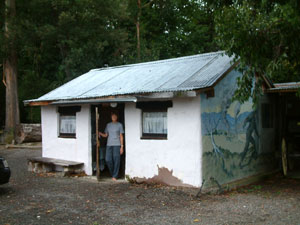 Pisé Hut at The Staging Post |
Day 1: Staging Post to Ngaroma
|
Soon, however, we headed coastward, following a narrow path down the steep gully of Buntings Stream, where native bush still held sway over the weedy invaders. Heading deeper into the hills and slowly climbing up a long ridge, the track took us through remnant beech forest, their trunks black with mould growing on sweet-smelling honeydew exuded by colonies of scale insects. These remnant bush gullies provide a refuge for native birds and they seemed alive with the calls of bellbirds as we passed through. |
 Old matai tree in Bunting's Bush |
|
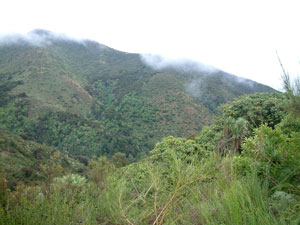 Climbing the Hawkswood Range |
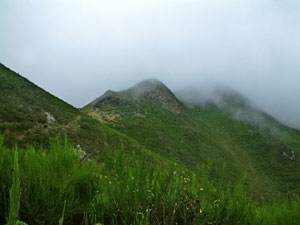 Fog obscuring Skull Peak |
|
|
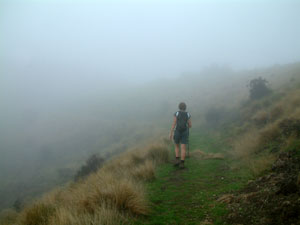 Nello disappearing into the mist |
Soon, out of the mist, the welcome shape of Skull Peak Shelter emerged, with its facilities to brew a hot cuppa. It was a good place to stop and get to know the other trampers a bit better. |
 Skull Peak Shelter overlooking the Kaikoura Coast |
As we sat and sipped our coffees and teas, the mist and cloud drifted by up the valleys, tantalising us with glimpses of the coastline, before finally lifting enough to see the panoramic view of Skull Peak and the broad expanse of green farmlands flowing away beneath it to the Pacific Ocean. Ten minutes later, the fog closed in again; it was time to head on for our long descent to the coast. |
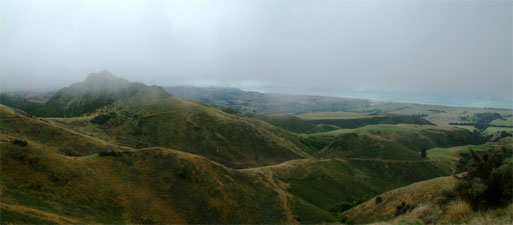 The clouds lift to reveal Skull Peak and the Kaikoura coastline |
|
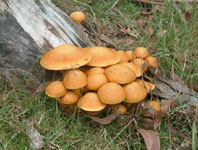  |
||
|
||
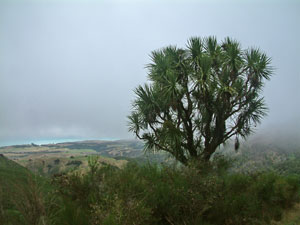 Cabbage tree silhouette |
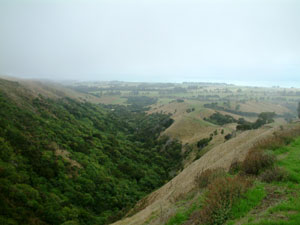 Typical landscape of native bush gully and pasture-covered ridges |
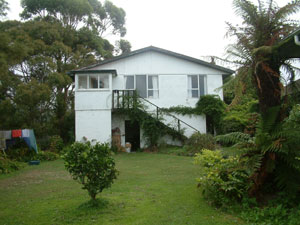 The Loft at Ngaroma |
 View from the window of The Loft towards the Seaward Kaikoura Range |
|
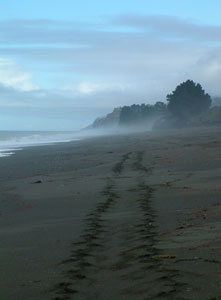 Leave only footprints |
|
 Evening stroll on the black sand beach of Kaikoura |
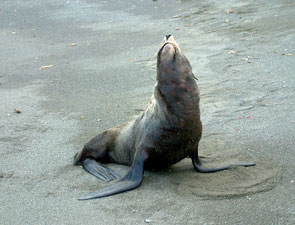 The complete and utter disdain of a fur seal |
|
Day 2: Ngaroma to Medina Walking down the short gravel road from Ngaroma homestead to the beach, the sun burst through and, as we turned south, shone warmly on our backs. We followed the coast road for a several hundred metres before dropping down on to the black sand of the beach. Ahead of us, the white, tan and golden cliffs gradually rose higher and higher to the south, behind us the pale grey silhouette of the Kaikoura Peninsula and the Seaward Kaikoura Mountains stood out against the morning sun. We ambled slowly along the beach, the waves breaking gently onto the shore and spreading out in a thin white foam which was quickly swallowed up by the black sands. |
|
|
We ambled slowly along the beach, the waves breaking gently onto the shore and spreading out in a thin white foam which was quickly swallowed up by the black sands. The deeply eroded cliffs of Kaikoura were about to give us a lesson in the forces that have shaped this landscape. Just past Sawpit Creek, we saw the first remnants of the buried forest, branches and twigs protruding from the smooth tan walls of the cliffs where they had been buried some 8000 years ago by wind-born sediments. This was still preserved wood, not yet fossilised. A little later, several large stumps of the ancient podocarps protruded from the black sand, the timber polished by millenia of waves washing over them. |
 Remnant of the 8000 year-old buried forest |
|
 More recent timber awaiting burial |
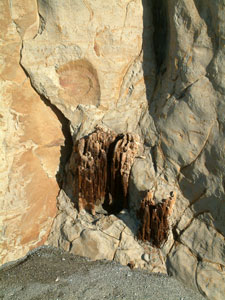 8000 year old pieces of wood protruding from the clay cliffs |
|
 Looking back to the north |
Further on the cliffs changed form; the horizontal layers in the loess sediments giving way sharply to the conglomerate of an ancient river delta, and later to a finer rock of marine origin, complete with bands of tiny shells, as the history of these deeply eroded cliffs unfolded. As we followed the beach, we passed a succession of deep clefts that marked the course of present day streams flowing out to sea - at times walking on soft black sand, at times crunching our way over a bed of flat black shingles. |
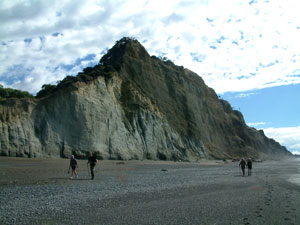 Sharp change from conglomerate to smooth marine sediments in the cliff-face |
|
Eventually, we reached a wider gap at Medina Creek and, each grabbing a load of bone dry driftwood, we turned into the gully to the Circle Shelter. Here the track operators have placed a shelter and fireplace, where we could sit in the sun, light a fire and boil a billy for a hot cuppa, while taking in the tranquillity of this ancient Maori campsite.
Cuppa over, we headed off again, staying inland and climbing up to the cliff line and the southern end of Medina Gully. To the north, we looked down on the long line of cliffs and ribbon of black sand that we had just walked down. Heading south again, we followed the cliff edge along a fenced paddock, rich with the cabbage-scent of a rape forage crop. |
 Northward view of our path at the base of the cliffs |
|
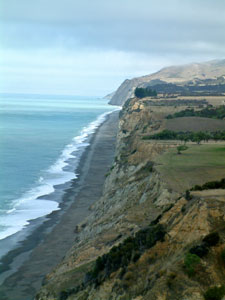 The long cliff -line stretching south toward the horizon |
At the top of the paddock, we reached the high point of the cliff line, from where impressive views could be had to the north and south of this isolated stretch of cliffs disappearing into the distance in a rail straight line between the green-blue sea and the paddocks of the coastal strip. |
We turned and followed a fence-line inland, keeping to the terrace alongside the steep southern edge of Medina Gully, before descending down into the gully and crossing the creek on a quaint log bridge. Clouds had begun invading the sky and the sun started to fade as we entered the bush of the Water Supply Gully, an area where stock were fence out over 20 years ago and the native forest has regenerated. Some original forest still remained, particularly impressive being an 800 year old Kahikatea and Matai tree, towering above the canopy of regenerating bush. What stories they could tell! Coupled with regeneration, the owners have undertaken extensive stoat and possum control, and the birdlife here was amongst the richest we have seen in New Zealand. A chorus of bellbirds and other songbirds followed us as we wandered through the steep walls and dense vegetation of the gully and fantails appeared at every bend to hunt the insects that we disturbed as we passed. |
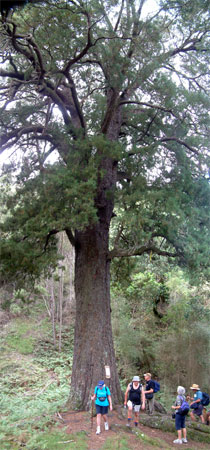 The 800 year old kahikatea |
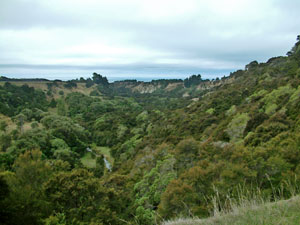  Two views of the regenerating bush in Medina Creek and Water Supply Gully - now home to a rich birdlife |
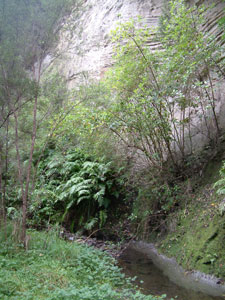 In the Water Supply Gully |
Finally, we climbed up out of the gully to reach a hilltop pasture. The first drops of rain began to fall as we crossed it, descended another hill, rounded a large pond and climbed up to Medina homestead. Here there are two places for trampers to stay, a larger wooden cottage called "The Whare", which can hold 8 and a delightful garden cottage which sleeps 4. The fair Nello and I plus Dutch couple, Co and Ria, stayed in the cottage, leaving the 6 kiwi friends together at The Whare, but that evening we all joined up for a long pleasant dinner, during which many tales were told and many laughs were had. Over the course of dinner, we realised that this was the first time we had been the youngest people on a walk and from the examples of our fellow trampers there are still a lot of kilometres left in our legs! |
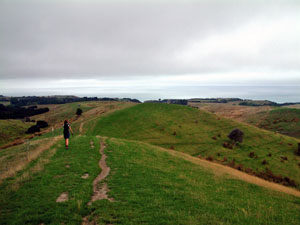 Crossing the paddocks of Medina |
Day 3: Medina to Staging Post It looked like being a strange day - weatherwise - as we ate our breakfast on the outdoor table at the Medina Garden Cottage in the early morning sun, watched by a few curious sheep and farm dogs. The top of the Hawkswood Range was clear, but a long band of cloud hovered just off-shore. With directions from Sally, our host, we set off, dropping down to cross a creek before commencing a steady climb up through the green paddocks, dotted with grazing sheep, and up into the broom and gorse covered hillsides. |
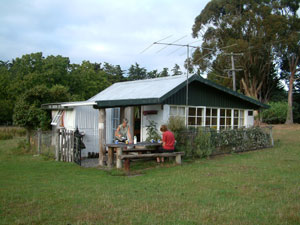 Breakfast at the Medina Garden Cottage |
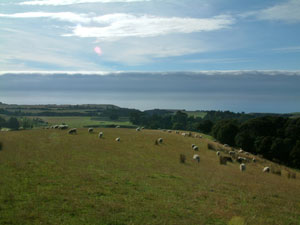 Sheep grazing contentedly as the sea-mist rolls in |
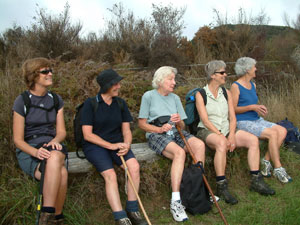 Photo of the girls posing for a photo |
Leaving behind the bucolic views of undulating farmlands stretching down to the sea, the track began to wind more steeply up the hills of the Hawkswood Range, as the cloud band moved in from the sea and began to swirl around the tussock grass of the higher tops. By the time we reached our high point for the day (and the walk) at 647m Mt Wilson, we were back in the deep mist and the grand views out toward the Inland Kaikoura Range were again denied us. |
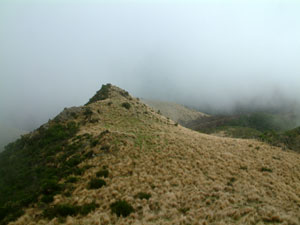 Back amongst the tussock ridges and mists of the Hawkswood Range |
 Last view of the coast before entering the fog |
 Great moments in mountaineering no. 61345 - Nello conquers Mt Wilson |
From Mt Wilson we dropped down to the Mt Wilson Shelter for a short break, before continuing our descent of the inland slopes of the coastal hills. As we wound down through thick infestations of broom we emerged into the sun; the mist had not spilled over from the seaward side of the hills. Before us lay the curious lumpen profile of the aptly named Humpy Hills. At the saddle between them and the Hawkswood Range, the track dropped down into a gully refuge of native bush and followed the Chilly Stream down before crossing it to climb gently back up and sidle along the paddocks of Hawkswood property. The hills behind us sparkled green in their mantle of broom. |
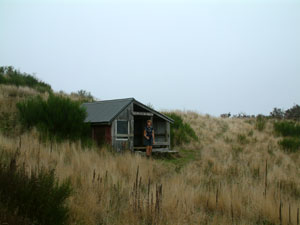 Mt Wilson Shelter |
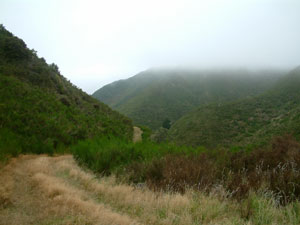 The track through the biggest broom infestation that I have seen |
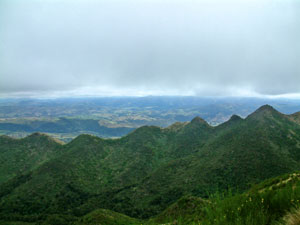 Profile of the Humpy Hills |
Finally, we rounded a small domed hill to see the red shed roof and buildings of Hawkswood below us; we took the time to admire the tranquillity of the rolling landscape one last time, for our walk was almost over. All that remained was one last steep descent to recross the Chilly Stream and an even steeper but short climb back out to reach the property and a stroll past silver wattles, sycamores and oaks to the cabins of the Staging Post, where we had started out two days earlier. |
|
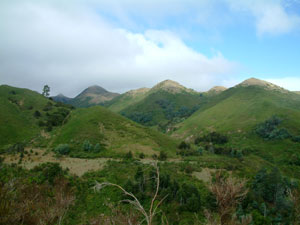 Hawkswood Range from the Chilly Stream |
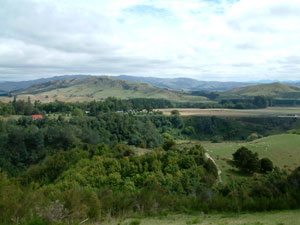 Looking across the Chilly Stream to The Staging Post |
|
|